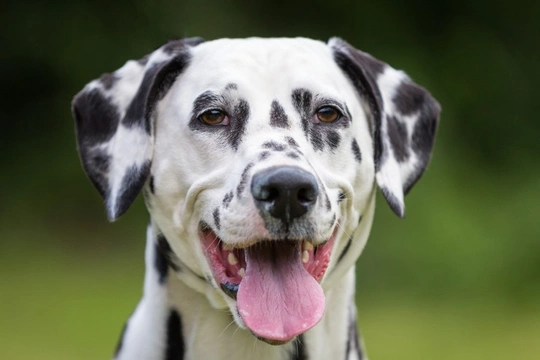
Are Dalmatians predisposed to developing bladder stones?
The Dalmatian is a very handsome and distinctive-looking dog breed, and one that many of us have had a soft spot for since childhood, when most of us will have seen the popular film 101 Dalmatians and fallen for the breed’s charms!
However, owning a Dalmatian can be complex and challenging – they’re a very energetic and high energy breed that often has a short attention span, and they’re also predisposed to a range of hereditary health conditions, including potential deafness, which is widely spread across dogs of the breed as a whole.
Another health condition that is associated with Dalmatian heredity is hyperuricosuria, or bladder stones. Bladder stones and crystal formation can be a problem in a wide range of individual dogs regardless of breed, particularly in older male dogs – but interestingly, a specific gene mutation that can be found within the Dalmatian breed actually increases their risks of developing urinary crystals, which may form into bladder stones.
In this article we will explain why Dalmatians have higher risk factors for bladder stones and crystals, how these stones form, and what they mean for your own dog. Read on to learn more.
What are bladder stones?
If the chemical makeup of your dog’s urine and the different elements contained within it become unbalanced, this can lead to the development of crystals in the dog’s urine, which come in various different types depending on the elements involved. Calcium oxalate crystals and struvite crystals are the most common types found in dogs, and these crystals aren’t harmful initially and won’t cause any symptoms in your dog – unless or until they form into stones.
In Dalmatians, on the other hand, bladder stones form from urate crystals, and over time these crystals too can form into hard clumps, known as bladder stones, and these can cause a number of problems.
Bladder stones can block the urethra and lead to pain when urinating, bloody urine, and even a total blockage, which is a veterinary emergency. Smaller bladder stones might be passed naturally within the urine, although this can cause pain and discomfort for your dog, but some stones can only be cleared with veterinary intervention.
Why are Dalmatians at higher risk of bladder stones?
Bladder stone formation and the crystals that cause them are associated with imbalances in the body’s chemistry, and the chances of stones developing increase in dogs fed dry food and that don’t drink enough water – like many dogs.
However, a gene mutation has been identified within the Dalmatian breed that leads to high levels of uric acid in the urine, which increases the production of crystals and so, the risk of the crystals forming into bladder stones.
This genetic predisposition to urate bladder stones is unique to the Dalmatian breed, and is thought to have been introduced due to selective breeding to produce a more desirable spotted pattern to the Dalmatian coat.
Bladder stones caused by this genetic predisposition take a while to develop, and occur most commonly in adult and mature Dalmatians, particularly (although by no means exclusively) males, and can be worsened by feeding dry food, as this means less water within the dog’s body to dilute the urine and flush out crystals.
How would you know if your Dalmatian had bladder stones?
Urinary tract infections, problems passing water, bloody urine and apparent pain when urinating are all potential indicators of bladder stones in Dalmatians. If your Dalmatian seems to be frequently affected by UTI infections or if they keep getting flare-ups of cystitis, your vet is likely to explore the possibility that your dog has bladder stones.
Because bladder stones can be very painful and uncomfortable for your dog, as well as increasing the likelihood of urinary infections and secondary damage occurring – as well as the fact that bladder stones may block the urethra, which is an acute emergency situation – All Dalmatian owners should be vigilant to the symptoms of bladder stones, and talk to your vet if you have any concerns.
How are bladder stones treated and managed in Dalmatians?
Research conducted both within the UK and the USA indicates that all members of the pedigree Dalmatian population carry the gene mutation that leads to uric acid production, which in turn causes crystals to form and potentially escalate into bladder stones.
Outcrossing to similar but unrelated breeds – like the Pointer – is the only way to begin removing this trait from the Dalmatian breed, but outcrossing produces non-pedigree dogs, and so is rarely undertaken on any meaningful scale.
Fortunately, feeding your Dalmatian a special diet to counteract their uric acid production and the purines within their bodies, which is the building block for uric acid crystals, can help to keep your Dalmatian healthy. This diet stops crystals from forming, and no crystals means no bladder stones!
However, you will need to talk to your vet and arrange to buy a special prescription diet for your Dalmatian to provide for their needs, and to prevent crystals and stones from developing, and clear and eliminate any that have already formed.
Large bladder stones cannot always be dissolved and resolved through dietary changes alone, and may require veterinary intervention, either to remove the stones surgically or to break them up with a different type of procedure using a laser or sound waves so that they can be passed naturally from the body.
If you buy or adopt a Dalmatian, arrange an initial consult with your own vet and talk to them about the right diet to prevent urinary crystals from developing.



